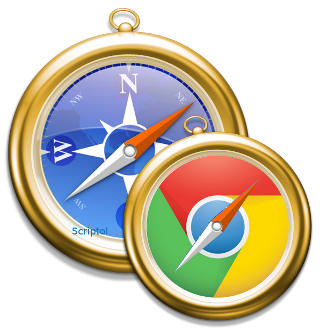Webkit, rendering engine and forks
Safari's rendering engine, because it's compact, has equipped toolbars for rendering pages, but now tends to skip hands.

To create its new browser, Safari, Apple abandoned Gecko and preferred runtime KHTML for Linux, which displays pages under the Konqueror browser.
Subsequently, Apple launched the WebKit project in 2001 using the KHTML code, which becomes open source in 2007 or more specifically, becomes available for third-party use.
It is also used on Apple and Nokia mobile devices. It replaced Gecko in Gnome's Epifany browser under Linux.
Google launched its Chrome browser in 2008, taking the WebKit code associated with the ultra-fast JavaScript compiler that started the race to speed JavaScript engines. It was also used on Android.
Subsequently, Google, in turn, launched a fork of WebKit - Blink, which replaced it with Chrome and Android in 2013.
Opera used WebKit in the Ice browser for smartphones as a replacement for Presto, its own rendering engine. This browser has a minimalistic interface.
But she has been using Blink on all her browsers since 2013.
Based on Ballmer's overly optimistic interpretation of the words, there were rumors that Microsoft might use WebKit for some of its products, but this was subsequently denied by the interested party. The phrase was rather ambiguous:
"The open source is interesting. Apple has adopted WebKit, and we can see from this side, but we will continue to create extensions for IE 8." (Sydney Developers Conference in November 2008.)
However, Microsoft is a member of WebKit to use some of its programs in the browser.
WebKit 2 is a new version that separates web pages and applications from the browser itself, as Chrome already does. It is used by Apple, but has never been used by Chrome, which already had its own architecture for this effect .
It was separated from the modified version used by Google to create Blink on April 3, 2013. This version of the engine in Chromium uses separate processes for each iFrame, which is safer.
Webkit is not the most used rendering engine, which depends on the market share of browsers, as well as on its use in tools such as Qt or Node-Webkit (which originally used Webkit, hence the name, but then switched to Blink).
Rendering engines for other browsers are:
- Microsoft's trident for the late Internet Explorer since version 4. (1997).
WebKit is fully compatible with Internet standards, unlike the Trident rendering engine prior to versions 9 and 10 IE. - Gecko from Mozilla for Firefox. (1998)
- Presto of the Opera. It has been the successor to Elektra since version 7 (2003). But Blink succeeded in 2013 .
- Gazelle. This is a rendering engine and browser project that would work as an operating system .
- Servo. The new Mozilla browser is written in the new system language Rust.
- EdgeHTML. For the "Microsoft Edge" browser that accompanies Windows 10.
History
- 1998. KHTML development.
- 2000. Distributed KHTML - HTML rendering engine for Linux Konqueror browser.
- 2000. KSJ is a JavaScript interpreter for Konqueror, and complements KHTML.
- 2001, June 25. Apple creates a fork from KHTML and KJS called WebKit.
- 2003, Jan. Apple's Safari browser announcement (at MacWorld).
- 2005, June. Apple is obliged to make all code available to everyone. It was completed in January 2006.
- 2008, Sept. Google's new Chrome browser is powered by Webkit. But it uses Google's own JavaScript compiler, V8.
- 2010, April 8. Announced the WebKit 2 project.
- 2010, Aug. Konqueror and KDE can use Webkit or KHTML as their choice.
- 2013, March 7. Apple serves up the WebKit brand.
- 2013, April. Google, in turn, forks and creates Blink, in a formed set of V8 and Blink called Chromium. Chromium tends to replace WebKit in other tools as well.
- 2014, May. Webkit FTL JIT is a new JavaScript interpreter, partially based on LLVM, that allows you to optimize and speed up your code more. Only part of the code is compiled for LLVM. It is enabled by default on MacOS and iOS .
For more information, see:
- WebKit. Site.
- Use WebKit for local application. Linux Magazine/English.
This is due to the use of the Qt and QtWebKit frameworks, which are impressive in size but portable and fairly easy to use.
See also
- Chrome.
- Qt. GUI library that includes Webkit.
- WebGL. A 3D library for the Web based on OpenGL is supported by Webkit (and displayed in Canvas ).
Opera goes under WebKit
Opera
![]()
For Android and iOS, Opera's WebKit-based browser is called ICE. The advantage under smartphones is that WebKit is also a native rendering engine, giving ICE faster access to hardware. For desktop PCs, this allows Opera to share all the achievements of WebKit, in which it also undertakes to participate. His first involvement in it concerns the organization of pages in columns.
This is good news for web application developers and webmasters: the compatibility problem is less. For Internet users, this will offer a different interface. On mobile Opera, 15% of the market share in 2013 according to StatCounter.